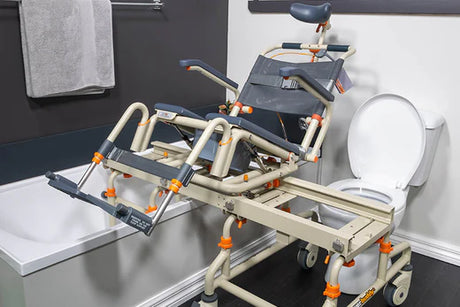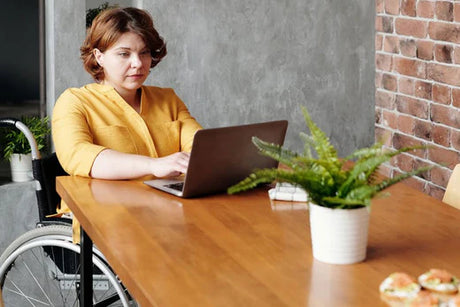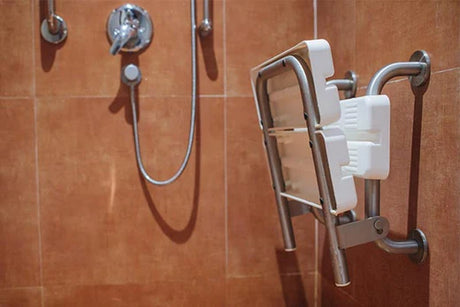The information in this article is intended as a general guide only. Consult with your occupational therapist for help with making bathing safe.
Latest in our bathroom safety series is the bathtub. Many homes have a combined shower and bath unit which offers versatility for everyone in the house. For someone with a mobility impairment however, a bathtub presents some challenges. That is, unless they have a system like Showerbuddy’s TubBuddy Tilt. But what can be done to enjoy a bathtub shower experience, safely? We’ll cover some areas of bathtub preparation that will ensure users and their carers are able to get through this daily routine with ease.
Keep the bathtub clean
Before anything – the floor and sides of the bath should be free of hair, grime and soap scum. It’s a good idea to do a deep clean of the bath with cleaning products and hot water, before drying off the entire tub with a towel or allowing it to dry before use with support equipment.
An unclean bathtub isn’t just unhygienic for everyone to use, it creates a slippery surface which is hard to secure a base or showerchair onto. The TubBuddy range locks in place with grip feet and side stabilisers, but it’s always worth installing this into a perfectly clean tub.
Along with surface cleaning, remove objects and debris from the outside edge of the tub – these can interfere with bathing. Once you’ve got your transfer solution in place, objects like body wash can be contained in a shelf or area well out of the way of the shower chair and user in all body positions (e.g. a tilted back angle). And finally, don’t forget to clear the floor of the bath. Objects in the bottom of the tub like toys just create more opportunity to catch whilst transferring in and out.
Have a securely fastened shower chair

Make sure your chair is securely fastened – as we have mentioned, the TubBuddy Transfer Range comes with a bath base that locks it in place with both floor and side grip, adding extra stability. The OT can ensure installation of a shower chair is fit for use, as it should be able to remain firm with significant weight placed upon it from all directions.
Put together a safe transfer plan
Equipment is one piece of the puzzle. But a plan is absolutely critical to any positive bathing routine. Together with carer and OT, the mobility impaired user will discuss and formulate a strategy around preparation and movements needed for a safe transfer.
Usually this plan will incorporate safety checks, running through the transfer onto the chair, entering the bathroom, getting ready for bathing, transfer, use, and transfer out again. By having these stages choreographed out, both carer and individual can work together to make it a smooth experience.
Over time, the plan might change – this is typical for those who are rehabilitating an injury towards recovery or at least improved mobility. This is why OTs and their clients will regularly meet to discuss whether the current programme is working or needs adjusting.
Ensure temperature and fixtures are protecting the user from burns
A shower that’s used by someone with a mobility challenge needs to have its hot water supply controlled to avoid a burning temperature at maximum setting. With an inability to react and move out the way of a burning water hazard, a disabled person is at risk of severe burns. Even if the bathing stage is done alone, it’s a good idea to have a support person nearby in case something does happen. Talk to your plumber for help if you need help with reducing the maximum setting on your hot water cylinder.

Grab Bars
A safely secured railing to grab and move with can help make bathing safer. However, these require destructive installation in the wall which makes them less than ideal for a rental property. If you, your family member or your client is a homeowner with a long term disability, grab bars might be a worthwhile investment provided there is enough arm mobility to get the most from these.
Take care when choosing grab bars as these come in different configurations and attachment methods. Rails should be firmly affixed to the wall as any give or loose fixture could spell disaster when weight is applied in a slippery environment.
Anti-slip floor covering
Anti-slip floor covering is a popular and affordable choice for many households – even those without an elderly or disabled family member. Older baths can lack the textured moulding of modern units designed to help grip.
For these baths, anti-slip mats might help everyone enjoy a more stable shower experience. Just care not to place a mat anywhere near a shower chair base if that’s in use, as the base should be securely fastened directly to the tub. Of course, a slip mat is not a practical single solution for anyone with a serious physical disability.
Get a full shower transfer system without any needed remodelling
Ultimately, the safest way to enjoy a shower with a disability is with a Showerbuddy system. Our range of chairs combine years of research with award winning industrial design to create a solution that helps those with disability across the globe enjoy much improved comfort and independence in the bathroom. Using a chair, bridge and base format, SB2 range allows the user to be transferred into the bathtub, unimpeded and with no strain on them or their support person.

Are you looking for a better solution to using the bathroom? Why not get in contact with our team now for a free consult. Or, find your nearest Showerbuddy distributor here and reach out directly for local pricing and details.
Further Reading
- Bathtub Accidents Injure 43,000 U.S. Kids Each Year – Medicine Net
- Home modifications – NZ Govt
- Grants for Home Modification: 16 Resources for Homeowners with Disabilities – Home Advisor






















![Toilet Training A Young Child With Mobility Challenges [And How A Shower Chair Can Help]](http://shower-buddy.com/cdn/shop/articles/toilet-training-disabled-child_520x500_a90e5234-d372-435d-aa56-8da15dd3836c.webp?v=1722557239&width=460)




























